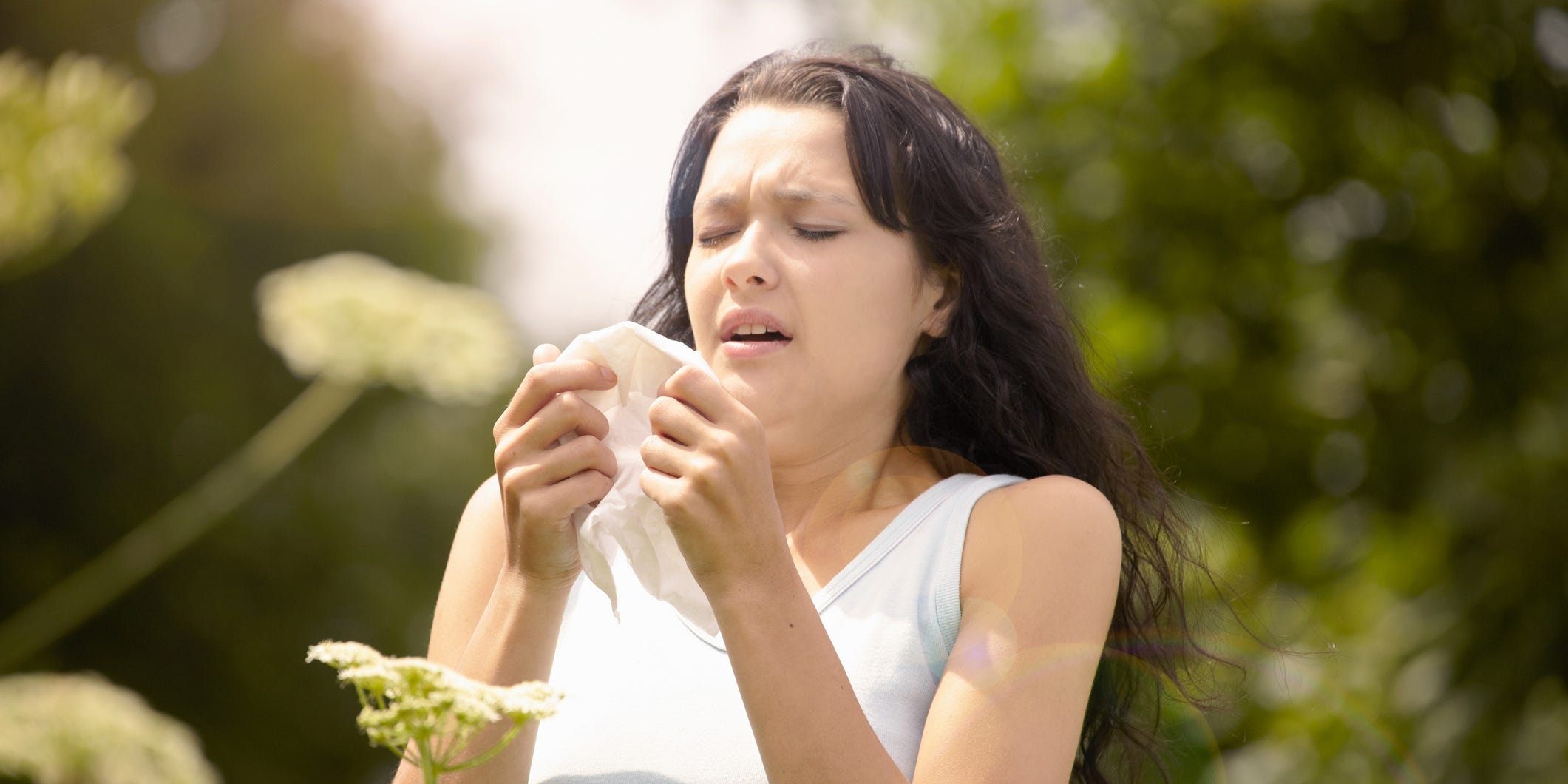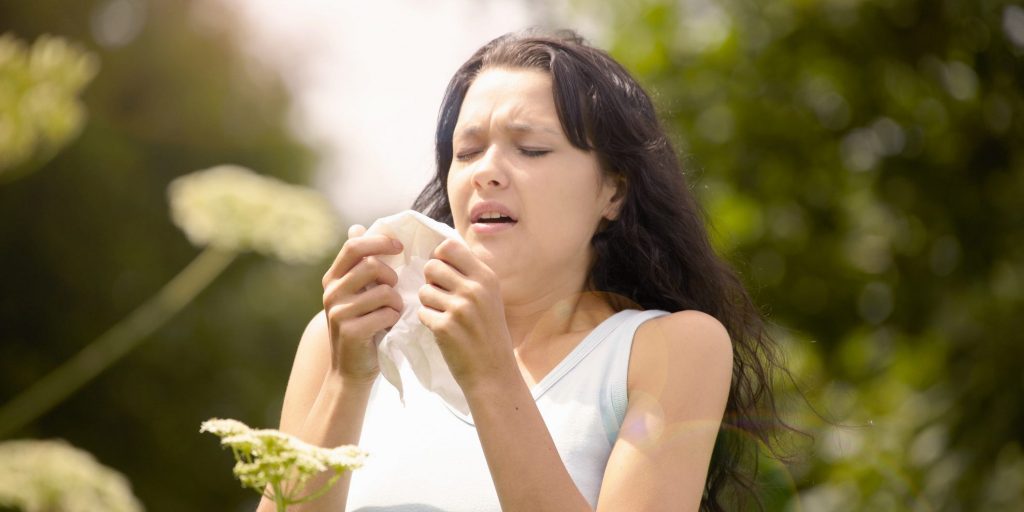
Martin Leigh/ Getty Images
- Hay fever is an allergic reaction to common substances such as dust or pollen.
- Some of the symptoms of hay fever include coughing, sneezing, a runny nose, and swollen eyelids.
- You can treat hay fever with medications such as antihistamines or intranasal steroid sprays.
- Visit Insider's Health Reference library for more advice.
The symptoms of hay fever can feel a lot like having a cold – you may be coughing, sneezing, or have a runny nose. But unlike a cold, hay fever is caused by an allergic reaction, not a viral infection.
Here's what you need to know about how hay fever affects you and what you can do to treat it.
What is hay fever?
Hay fever is an allergic reaction to common substances such as dust or pollen. Another name for hay fever is allergic rhinitis. There are two types of allergic rhinitis:
- Seasonal allergic rhinitis: Seasonal allergies are generally caused by pollen and shift from season to season, depending on which plants are blooming. Most people tend to have worse allergies in the spring.
- Perennial allergic rhinitis: Perennial allergies can hit year-round and are often caused by indoor substances like dust or mold.
What causes hay fever?
When you have an allergy to something, it means that your body overreacts to substances that are generally harmless to other people. For example, when you breathe in tree pollen, your immune system identifies that pollen as a dangerous foreign invader that must be destroyed.
In response, your immune system produces antibodies that then trigger the release of chemicals, called histamines. These histamines are what cause the runny nose, itchy eyes, and sneezing that are common symptoms of hay fever. And it's these symptoms that are meant to help you expel the allergen from your body.
Common triggers
Some common triggers of seasonal allergies are:
- Early spring: tree pollen
- Late spring and summer: grass pollen
- Fall: ragweed pollen
Triggers of perennial allergies include:
- Dust mites
- Cat and dog fur and dander
- Pests like mice and cockroaches
- Various types of mold and fungi
Allergies can also be triggered by substances that irritate your sinuses like perfume, cigarette smoke, and car exhaust.
Symptoms
Most people are familiar with common allergy symptoms, but there are many other effects of hay fever, including some that can cause serious problems.
Some allergy symptoms include:
- Coughing and sneezing
- Runny or stuffy nose
- Eyelids swelling up
- Itching in your eyes, nose, mouth, or throat
- Difficulty concentrating or making decisions
- Memory issues
- Irritable mood
- Fatigue or difficulty sleeping
If you start to feel unwell, there are a few key signs to help you tell the difference between allergies and a cold.
Hay fever generally doesn't cause symptoms like fever, decreased appetite, muscle soreness or gastrointestinal side effects, while some colds can, says Sedaghat.
"Symptoms of the common cold and the flu often will also start to improve after 3-5 days," Sedaghat says, "while allergies, in particular seasonal allergies, may linger for longer."
Hay fever in children
For very young children, hay fever can cause moodiness because they are distressed by their symptoms and can't express how they feel. Children suffering from allergies may act out at home or at school.
Children with allergies can also develop ear infections from fluid build-up and this can impair their hearing. For babies, it's especially important to treat ear symptoms, as they can interfere with speech development.
Having a stuffy nose can also be a serious issue, as children may begin breathing through their mouths, which can cause problems with the growth of their teeth.
Treatment
There are three primary ways that allergies can be treated.
1. Avoid triggers: If you're suffering from seasonal allergic rhinitis, one step you can take is to stay inside on windy days, when the amount of pollen in the air is usually higher. You should also keep your windows closed to keep outdoor allergens from getting in.
Lastly, you can wear glasses or facemasks to protect yourself, especially when doing yard work. If you have year-round dust allergies, you can also use dust-proof covers on your pillows and mattress to reduce your dust exposure.
2. Use medications: Most people use medications for relief, Sedaghat says. This includes antihistamines, such as Diphenhydramine (Benadryl) or Cetirizine (Zyrtec) which block the effects of the histamines that cause allergy symptoms.
You can also use intranasal steroid sprays, like Fluticasone (Flonase) or Triamcinolone (Nasacort), that reduce the inflammation caused by allergies. You can find both of these options over the counter at any pharmacy to help treat both allergic and perennial hay fever.
3. Try immunotherapy (allergy shots or tablets): For people who aren't getting enough help from medications, or who want a permanent solution to allergies, immunotherapy can be a good option.
"It is the only treatment we have that actually changes the immune system for any disease," Sedaghat says. Immunotherapy works by giving you very small doses of allergens over the course of 3 to 5 years, allowing your body to build up a resistance.
Insider's takeaway
Hay fever is an allergic reaction that feels similar to a cold. You might experience a runny nose, sneezing, and itchy eyes.
If your allergies are not under control using avoidance and over-the-counter medications, you should see a doctor or an allergy specialist to explore your treatment options.
